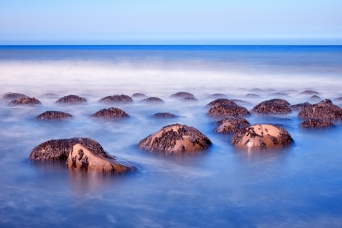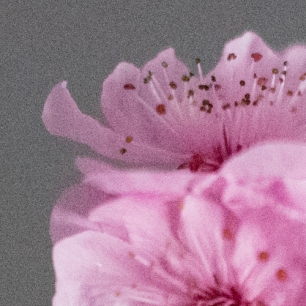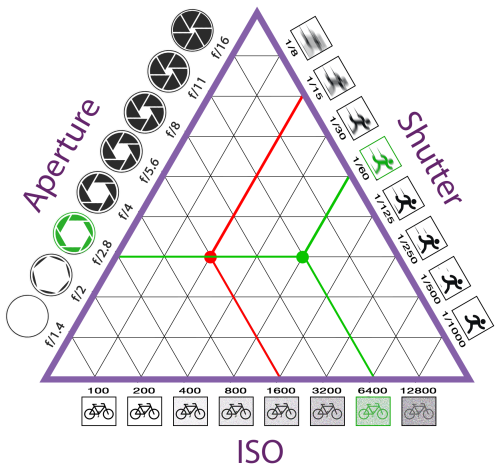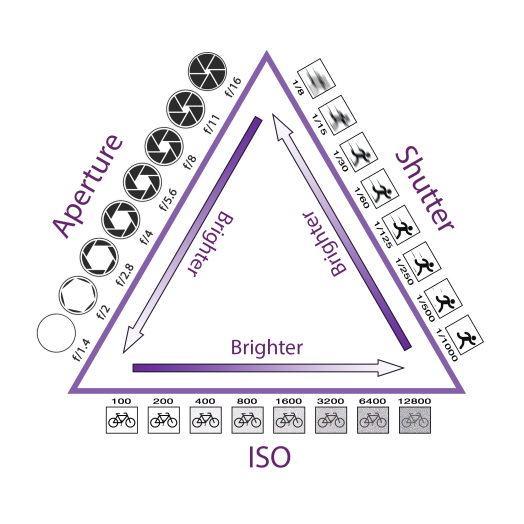Aperture, Shutter Speed and ISO
They work together to create an exposure and affect your image in different ways.
If you missed the individual articles you can find them here:
Aperture – Shutter Speed – ISO

You can change the level of brightness in a photograph in these 3 different ways:
- Aperture – How much light passes through the lens
- Shutter speed – How long the sensor is hit with light
- ISO – How much the processor amplifies the light collected by the sensor
Each will affect your image differently:
Aperture affects depth of field



Shutter speed affects movement



ISO affects noise



One increment in any of these scales will either double the amount of light or halve it. This is known as ONE STOP.
Let’s take a look at aperture. We are going to start out at f/5.6




The same principal applies to the ISO and shutter speed scales. If we have an shutter speed of 1/250th of a second and we change it to 1/60th of a second then shutter will be open 4x the amount of time and our image will be 2 stops brighter.

This exposure is ONE STOP too bright.
ISO 400 f/16 1/250 sec
How can I correct it?
I can lower my ISO one stop, close my aperture 1 stop, or shorten my shutter speed 1 stop.
ISO 200 f/16 1/250 sec
ISO 400 f/22 1/250 sec
ISO 400 f/16 1/500 sec

All three elements work together in your camera to create the exposure.
The Exposure Triangle
The Rule of Equivalent Exposures
If you cut the light by half in one way, you must double it in another to retain the same level of brightness.
Let’s say that for a correct exposure my camera meter reads:
- Shutter speed of 1/15 of a second
- Aperture of f/2.8
- ISO 1600
But I know that I need a shutter speed of at least 1/60th to be able to hand hold my camera without shake.

I have three options to get to 1/60th of a second and keep the same exposure brightness in my photograph.
There is two stops of light loss by going from 1/15th to 1/60th, and I must gain that light back in another way to compensate and keep my exposure correct.

But I don’t want the noise that ISO 6400 will create, so I will look at changing my aperture.

And I think that f/1.4 would be too shallow of a depth of field,
So maybe a combination of changing ISO and aperture would work for me.

I was able to get the 1/60th of a second that I wanted and retain the proper exposure.
Aperture, Shutter Speed and ISO
They work together to create an exposure and affect your image in different ways.
You as the photographer get to choose every aspect of your photographs.
Be creative 🙂

All text and images by Melinda Walsh
To learn more about The Exposure Triangle check out our classes at Action Camera
Upcoming Classes at Action Camera in Roseville, Ca
Upcoming Classes at Action Camera in Reno, Nv



July 19, 2018 at 11:58 am
Very interesting, very informative, Thanks.
LikeLiked by 1 person
July 19, 2018 at 2:51 pm
Thanks Robert
LikeLike
July 24, 2018 at 5:42 pm
Excellent presentation of the ASI relationship. Easy to read and understand. Now I just have to retain it all……………:-)
LikeLike
July 24, 2018 at 6:13 pm
Thanks Bob 🙂
LikeLike
August 1, 2018 at 1:18 am
Fine way of telling, and fastidious post to get facts concerning my presentation topic, which i am going to present in university.
LikeLike
August 2, 2018 at 12:29 am
Thank you, I am glad I could help 🙂
LikeLike
October 14, 2020 at 7:09 pm
all these reviews are fake lol theres like 5 rolex replica usernames and i can obviously tell BOB FRANCIS is a bot so fake
LikeLike
October 14, 2020 at 11:50 pm
Hi mrkabs21, thanks for reminding me to go through and delete the spam. I haven’t done it in a while
LikeLike
October 15, 2020 at 12:11 am
Wow, there was a lot from Rolex people but I think I deleted them all. Thanks for the heads up
LikeLike
August 4, 2018 at 5:02 pm
Soy persona sorda, es muy interesante así que practico poco a poco :-))
LikeLike
August 15, 2018 at 9:02 am
I love your way of explaining and putting things together. Thank you.
LikeLike
August 15, 2018 at 10:03 pm
Thank you Tish 🙂
LikeLike
August 19, 2018 at 3:49 pm
A very easy way to learn the triangle method. Very well explained.
LikeLike
August 22, 2018 at 5:34 pm
Thank you John
LikeLike
August 22, 2018 at 11:51 am
Thanks I know have better understanding of these 3 ..excellent diagrams too
LikeLike
August 22, 2018 at 5:33 pm
Thank you Angela 🙂 I am glad I could help
LikeLike
August 29, 2018 at 1:46 pm
Good presentation! I like it.
LikeLike
September 1, 2018 at 4:56 pm
Good one, simple and understandable
LikeLike
September 15, 2018 at 5:01 am
very nice graf
LikeLike
December 1, 2018 at 8:38 am
Thank you so much for the information, it eas simple to understand, i now need to put to practice.
LikeLiked by 1 person
March 7, 2019 at 1:44 pm
superb article. I love it.
LikeLiked by 1 person
March 12, 2019 at 12:54 pm
I’ve not seen the triangle explanation before – quite unique and helpful. Thank you!
LikeLiked by 1 person
March 16, 2019 at 6:06 am
It too boom i like they way you put it thanks so much
LikeLike
April 7, 2019 at 6:42 am
Hi friends, fastidious post and good arguments commented
at this place, I am really enjoying by these.
LikeLiked by 1 person
June 19, 2019 at 11:05 pm
Thank you so much for this!
LikeLiked by 1 person
June 28, 2019 at 8:21 pm
This explanation is so simple and easy to understand. I am teaching a home school group of high school kids a very basic photography concepts class. Would you mind if I use this as one of my teaching tools? Thank you.
LikeLiked by 1 person
June 28, 2019 at 9:37 pm
I don’t mind at all 🙂
LikeLike
August 29, 2019 at 9:03 pm
This is really interesting, You are an excessively professional blogger.
I have joined your feed and sit up for in quest of more of your wonderful post.
Also, I have shared your website in my social networks
LikeLike
August 29, 2019 at 9:08 pm
Thank you so much Greta!
LikeLike
August 31, 2019 at 11:27 am
Have you ever considered publishing an e-book or guest authoring on other blogs?
I have a blog centered on the same topics you discuss and would really like to have you share some stories/information. I know
my subscribers would value your work. If you are even remotely interested,
feel free to send me an e mail.
LikeLike
September 30, 2019 at 11:21 am
Nice post. Do you have any other ones you can drop? I like the content. 🙂
LikeLike
December 24, 2019 at 7:23 pm
Wow that was odd. I just wrote an very long comment but after I clicked submit my comment didn’t appear. Grrrr… well I’m not writing all that over again. Anyhow, just wanted to say excellent blog!
LikeLike
April 18, 2020 at 11:21 am
Thank You for the great info on the triangle..I clearly could never just understand it..but I do now…..I keep a cheat sheet in my camera bag for retaining the info…..
LikeLike
September 3, 2020 at 7:38 pm
Very self explanatory… I’m just learning but this explains the very basics better than anything I’ve seen in YouTube… Thanks!
LikeLike
September 12, 2020 at 9:34 pm
When I learned in the film era (“stone knives and bearskins” — Spock) it was more like an exposure teeter-totter. You might shoot Tri-X at 800, for example, but you had to make that choice for the whole roll.
LikeLike
October 15, 2020 at 12:04 am
I learned in the film era too and I used to shoot part of my 35mm film then rewind it and pull the leader back out with that little metal gadget. A little more work to get to a triangle but it was better than a 36 exposure teeter-totter 😂
LikeLike
October 11, 2020 at 2:54 am
This blog was… how do I say it? Relevant!! Finally I’ve found something that helped me. Kudos!
LikeLike
April 29, 2021 at 3:07 pm
Dear Melinda, there are many explanations out there of the exp. triangle…but yours is one of the very best! Compliment! Would you allow me to use one of your graphics for my university presentation (the triangle)?
Thanx for a reply and best regards, Gregor
LikeLike
April 29, 2021 at 5:07 pm
No problem Gregor, feel free to use any of the graphics you like 😊
LikeLike
August 16, 2021 at 2:45 am
Best and simplest explanation I have seen of the exposure triangle – thank you.
LikeLike
August 21, 2021 at 6:00 pm
thanks for your post. I my opinion it’s the best “tutorial” I’ve seen on this subject. Everything’s seem so easy. I’ve appreciate the link and démonstration you’ve made with the Exposure Triangle. We seen very often the reference of this triangle but never the use is really explained.
LikeLike
September 12, 2022 at 10:43 am
triangles abc and cde are mathematically similar. This means that they have the same shape, but possibly different sizes. triangles abc and cde are both triangles, so they have three sides and three angles. The sides of triangles abc and cde are in the same ratio, so their angles must be in the same ratio as well. This means that triangles abc and cde are similar.Read another amazing blog: https://lead-academy.org/blog/triangles-abc-and-cde-are-mathematically-similar/
LikeLike